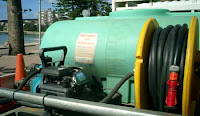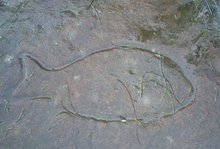 A day in Manly today, through the streets parked out with oozing boats. At the beach the spectacle of the day was staged by engineers 'fostering innovation'. A plane twirled in the blue sky, leaving behind thick black plumes of pollution. Greenhouse gas emissions rained on all the spectators. Apart from wasting fossil fuel, paper was thrown about on the beach as part of the 'family fun'.
A day in Manly today, through the streets parked out with oozing boats. At the beach the spectacle of the day was staged by engineers 'fostering innovation'. A plane twirled in the blue sky, leaving behind thick black plumes of pollution. Greenhouse gas emissions rained on all the spectators. Apart from wasting fossil fuel, paper was thrown about on the beach as part of the 'family fun'. AT Manly Village Public School Market, 4x4s parked out the bike path. In the playground a model rubber castle, hurling advertising was erected. Powered, as usual by petrol, exhausts of the motor, pumping non-stop into the playground. Carers did not seem to mind.The market ambiance was ruined by this noise pollution.
AT Manly Village Public School Market, 4x4s parked out the bike path. In the playground a model rubber castle, hurling advertising was erected. Powered, as usual by petrol, exhausts of the motor, pumping non-stop into the playground. Carers did not seem to mind.The market ambiance was ruined by this noise pollution. Manly 'lawn'- transplants looked yellow/white, despite the intensive petrol-watering.Thirsty foreign pansies in plastic planters were hanging out for their next shot of fossil-fuel powered water by Council.
Manly 'lawn'- transplants looked yellow/white, despite the intensive petrol-watering.Thirsty foreign pansies in plastic planters were hanging out for their next shot of fossil-fuel powered water by Council.
At the walk from the beach to Shelly, more trees have disappeared, providing much better views. Weeds spill down the sandstone walls of the 'CABBAGE TREE BAY ECO-SCULPTURE WALK “. Never before have we sighted Indian Mynas there. The absence of trees and increase of weeds must have created the right environment for these pests. Being one of the 'World's 100 Worst Invasive Species' they kill native birds and even Ringtail Possums. Parts of Manly town (Sydney Rd. etc) are already caked in their excrement which has ' the potential to spread disease to people and domestic animals.' The next spectacle is planning to civilise dog owners of Manly. What a task! “The aim of the day.. (is) to promote responsible pet ownership and to encourage pet micro-chipping and registration.” It could be years before dogs, tearing Little Penguin chicks to death can be located in real time and their owners charged. Regular dogs on beaches and National Parks could be traced and fines collected. An instant cure for investment headaches. Wonderful possibilities.
The next spectacle is planning to civilise dog owners of Manly. What a task! “The aim of the day.. (is) to promote responsible pet ownership and to encourage pet micro-chipping and registration.” It could be years before dogs, tearing Little Penguin chicks to death can be located in real time and their owners charged. Regular dogs on beaches and National Parks could be traced and fines collected. An instant cure for investment headaches. Wonderful possibilities.
In the afternoon rare visitors were at the rocky shores. Four Sooty Oystercatchers tried to feed in vain, but were repeatedly disturbed by humans until they finally gave up and flew out to the ocean. Even in protected areas, not many oysters have been left by very hungry and poor Australians. It takes some time for the bird to lever, prise or hammer open the shellfish.They are out of a habitat and are getting rare. In the image they are fleeing Manly.
18 August 2007
Birds, Pests and Petrol Culture at Manly Beach
Tags
birds,
pests,
petrol_dependence,
pollution
Subscribe to:
Post Comments (Atom)











No comments:
Post a Comment